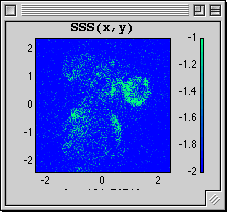 |

L. Yu and M.K. Kim, “Variable tomographic scanning with wavelength scanning digital interference holography”, Opt. Comm. 260, 462-468 (2006). > pdf
|
We present a new method for variable tomographic scanning based on the wavelength scanning digital interference holography
(WSDIH). A series of holograms are generated with a range of scanned wavelengths. The object field is reconstructed in a number of
selected tilted planes from each hologram, and the numerical superposition of all the tilted object fields results in a variable tomographic
scanning. The scanning direction can be arbitrary angles in 3D space but not limited in a 2D plane, thus the proposed algorithm offers
more flexibility for acquiring and observing randomly orientated features of a specimen in a WSDIH system. Experiments are performed
to demonstrate the effectiveness of the method.
|
|
L. Yu and M.K. Kim, “Pixel resolution control in numerical reconstruction of digital holography”, Opt. Lett. 31, 897 (2006). > pdf |
A new method for resolution control in numerical reconstruction of digital holography is proposed. The wave
field on a tilted or vertical plane can be reconstructed without being subject to the minimum object-tohologram
distance requirement, and the pixel resolution can be easily controlled by adjusting the position of
a transitional plane. The proposed method solves the problem of pixel resolution control for small object-tohologram
distances and is especially useful for multicolor, multiwavelength digital holography and metrological
applications. Experimental results are presented to verify the idea.
|
|
L. Yu & M.K. Kim, “Wavelength scanning digital interference holography for variable tomographic scanning”, Opt. Express 13, 5621-5627 (2005). > pdf |
We present a novel technique of variable tomographic scanning capable of reconstructing tomographic images of an object volume along any arbitrarily tilted plane. The method is based on wavelength scanning digital interference holography, using a series of holograms generated with a range of scanned wavelengths. From each hologram, the object field is reconstructed in a number of selected tilted planes. The desired tomographic images are then reconstructed from the numerical superposition of the object fields. Thus the tomographic images can be generated along variable planes without the need for physically repeating the scanning and recording processes. Experimental results are presented to verify the proposed concept.
|
|
Lingfeng Yu & Myung K Kim, “Wavelength-scanning digital interference holography for tomographic 3D imaging using the angular spectrum method”, Opt. Lett. 30, 2092-2094 (2005). > pdf |
A tomographic imaging system based on wavelength-scanning digital interference holography is developed
by applying the angular spectrum method. Compared to the well-known Fresnel diffraction formula, which
is subject to a minimum distance requirement in reconstruction, the angular spectrum method can reconstruct
the wave field at any distance from the hologram plane. The new system allows three-dimensional
tomographic images to be extracted with an improved signal-to-noise ratio, a more flexible scanning range,
and an easier specimen size selection. Experiments are performed to demonstrate the effectiveness of the
method.
|
|
A. Dakoff, J. Gass, & M.K. Kim, “Microscopic three-dimensional imaging by digital interference holography”, J. Electronic Imaging 12, 643-647 (2003). > pdf |
Digital interference holography (DIH) is being developed
as a novel method of microscopic 3-D imaging. A number of holographic
fields are numerically calculated from optically recorded holograms
using a range of wavelengths. Numerical superposition of
these fields results in a tomographic representation of the object
with narrow axial resolution. We demonstrate the practicality of DIH
in microscopic imaging with a set of preliminary experiments, yielding
approximately 3 mm of lateral resolution and 10 mm of axial
resolution, using a simple optical setup and straightforward numerical
algorithms.
|
|
M.K. Kim, "Tomographic three-dimensional imaging of a biological specimen using wavelength-scanning digital interference holography," Opt. Exp. 7, 305-310 (2000). > pdf |
The principle of wavelength-scanning digital interference holography is applied to three-dimensional imaging of a small biological specimen. The images are reconstructed from a number of holograms digitally recorded while the wavelengths are varied at regular intervals, and the numerical interference of the multiple three-dimensional hologram fields results in tomographic images with narrow axial resolution.An animated three-dimensional model of the object is constructed from the tomographic images.

|
|
M.K. Kim, “Wavelength scanning digital interference holography for optical section imaging”, Opt. Lett. 24, 1693-1695 (1999). > pdf
|
We propose and experimentally demonstrate a simple digital holographic method that allows reconstruction of
three-dimensional object images with a narrow depth of focus or axial resolution. A number of holograms are
optically generated by use of different wavelengths spaced at regular intervals. The holograms are recorded
on a digital camera and reconstructed numerically. Multiwavelength interference of the holograms results in
images of the contour plane whose thickness can be made arbitrarily narrow. Objects at different distances
from the hologram plane are imaged clearly and independently, with complete suppression of the out-offocus
images. The technique is available only in digital holography and should have useful applications in
holographic microscopy.
|
|
|
![]()

